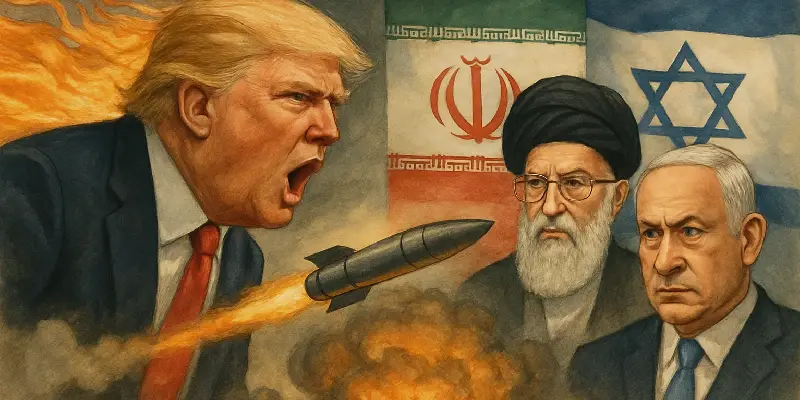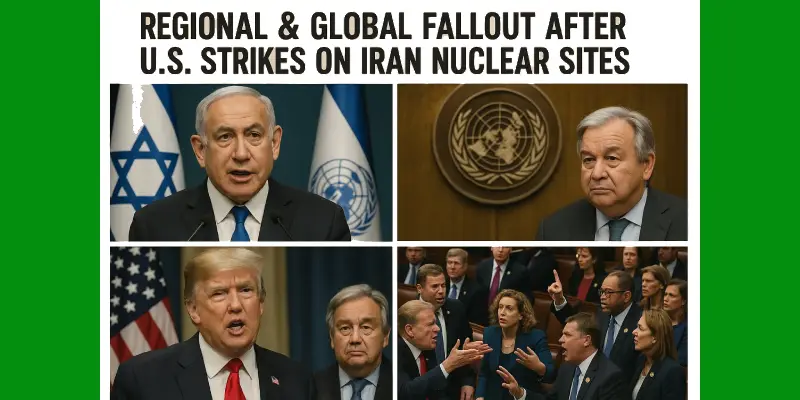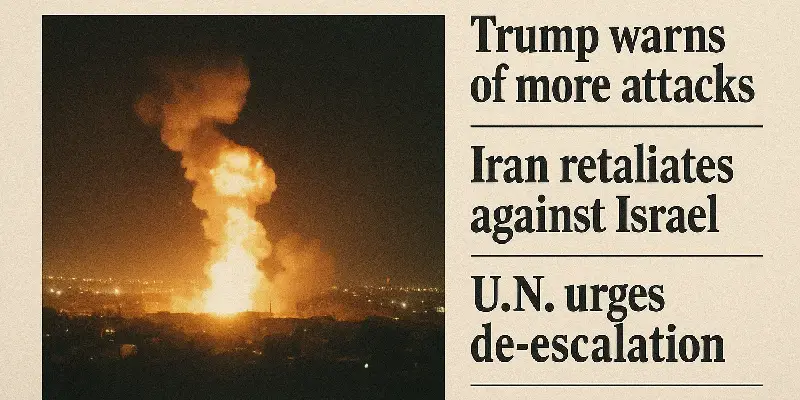Late on the night of June 21–22, 2025, former US President Donald Trump made a dramatic announcement confirming that the US airstrikes on Iran, specifically targeting three of its key nuclear facilities Fordow, Natanz, and Isfahan.
This bold US airstrikes on Iran nuclear areas involved B‑2 stealth bombers equipped with powerful bunker-buster bombs and Tomahawk missiles designed to cripple Iran’s nuclear capabilities.

Table of Contents
ToggleTarget Locations in the US Strikes on Iran Nuclear Sites
-
Fordow – A deeply fortified underground uranium-enrichment site.
-
Natanz – Iran’s primary enrichment complex.
-
Isfahan – A significant nuclear technology and research location.
Trump called the US airstrike on Iran a “spectacular military success” and warned Iran to choose peace or face further strikes, saying, “there are many targets left.”
Why the US Attacks on Iran Happened
According to Trump, the purpose of these US strikes on Iran nuclear sites was to:
-
“Obliterate” Iran’s nuclear enrichment ability.
-
Stop Tehran from developing a nuclear weapon.
-
Respond to Iran’s refusal to pursue nuclear disarmament.
Even though US intelligence reportedly did not confirm that Iran was close to producing a nuclear weapon, Trump insisted that the US attacks on Iran were necessary to eliminate what he described as a growing threat.
Iran’s Response to the US Airstrike on Iran
Soon after the strikes:
-
Iranian Foreign Minister Abbas Araqchi condemned the US airstrikes on Iran as “outrageous” and a violation of the UN Charter and the Non-Proliferation Treaty (NPT).
-
Iran warned of “everlasting consequences” and stated it “reserves all options to defend itself.”
-
Iran’s Atomic Energy Organization confirmed the strikes but vowed that its nuclear program would continue, demanding global condemnation of the US attacks on Iran nuclear areas.
-
Iran retaliated by firing 20–30 missiles toward northern and central Israel, causing minor injuries and some infrastructure damage.
Thankfully, no radiation leaks were reported by the IAEA or other environmental agencies.
Regional & Global Fallout After US Strikes on Iran Nuclear Sites

-
Israel praised the US airstrike on Iran, with Prime Minister Netanyahu calling it a historic move that supports Israel’s earlier military actions.
-
The UN urged both sides to de-escalate immediately to avoid a wider Middle East conflict.
-
In the US, reactions were sharply divided. Some Republicans praised the decision; others criticized Trump for acting without Congressional approval, sparking debate over the legality of the US attacks on Iran.
What the US Airstrike on Iran Means
This event marks a significant escalation as the US joins Israel directly in its campaign against Iran’s nuclear program. It also reflects a shift in Trump’s previous reluctance toward deeper military involvement in the region.
Analysts are warning of possible fallout, including asymmetric warfare, proxy attacks from Hezbollah or the Houthis, or even direct retaliation against US bases in the Middle East.
TL;DR Summary

| What Happened | Key Takeaways |
|---|---|
| US hit Fordow, Natanz, Isfahan | Aim: Cripple Iran’s nuclear enrichment |
| Bold Trump warning | “Many targets left” if Iran doesn’t seek peace |
| Iran enraged | Called it a UN treaty violation, vows defense |
| Iran struck back at Israel | Minor damage, at least 16 injured |
| Global tension rises | UN calls for calm; war risks spike |
What Comes Next After the US Strikes on Iran?
-
More US attacks on Iran nuclear areas or Iranian retaliation could follow.
-
Diplomatic efforts will be critical to prevent the situation from spiraling into full-scale war.
-
US political debates may intensify over the legality and consequences of this major US airstrike on Iran.
Frequently Asked Questions (FAQ)
1. Why did the US launch airstrikes on Iran’s nuclear facilities?
The US airstrike on Iran was aimed at crippling Iran’s nuclear enrichment capabilities. President Trump claimed that Iran’s refusal to disarm and the threat of nuclear weapons development forced this military action to prevent future risks.
2. Which Iranian nuclear sites were targeted by the US attacks?
The US attacks on Iran nuclear areas focused on three main locations: Fordow (an underground enrichment site), Natanz (the primary enrichment complex), and Isfahan (a nuclear research center).
3. How did Iran respond to the US strikes on its nuclear sites?
Iran condemned the US airstrikes as illegal under international law and launched 20–30 missiles toward Israel in retaliation. Iran also vowed to continue its nuclear program despite the attacks.
4. Was there any radiation leak after the US airstrikes on Iran?
No, according to the International Atomic Energy Agency (IAEA) and environmental authorities, there were no reports of radiation leaks from the bombed nuclear sites.
5. Could this lead to a bigger conflict between the US and Iran?
Yes, experts warn that the situation may escalate into further military strikes or regional conflict involving proxy groups unless diplomatic measures are taken quickly.
For more news and information visit our Home page Visualpakistan.com



